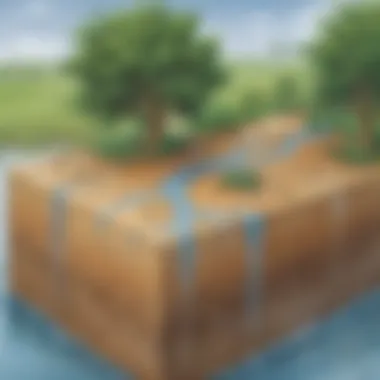Understanding Rainwater Runoff: A Guide for Young Scientists


Intro
Understanding rainwater runoff is a crucial aspect affecting our environment. This phenomenon occurs when rainfall accumulates on surfaces, leading to the water flowing, often uncontrollably, into streets, rivers, and oceans. As guardians of our planet, it is essential for young science enthusiasts to grasp not only the science behind this occurrence but also the implications it carries for ecosystems and urban settings. Not only does rainwater runoff influence water quality, it also plays a role in soil erosion and contributes significantly to flooding.
By learning the facts about rainwater runoff, children can evolve as informed stewards of their surroundings. Understanding the interaction of competing demands—from urban growth to conservation efforts—also shapes their perspectives as future decision-makers.As we journey through this guide, we will make connections that improve environmental consciousness among young minds.
Science Fun Facts
Young scientists can find joy in uncovering the secrets of rainwater runoff. Here are some interesting facts:
- Rainwater runoff plays a role in the natural water cycle, transporting water from the atmosphere to bodies like rivers and lakes.
- Urban areas inspire significant runoff conditions, since pavement and roofs do not absorb water effectively.
- Did you know? Approximately 55% of rainfall in cities leads to runoff, whereas only about 15% does in forests.
- Some small organisms, like amoebas, thrive in runoff—in different drainages, of course! They indicate the water's health.
Here is an amazing fact: runoff can carry pollutants from the roads and streets right into local water systems. Rainfall can wash away oil from vehicles, litter, and other debris.
Fun Trivia: A little rain produces a lot of flow; ever seen a puddle vanish? It can turn into fast-moving water in populated areas!
Explore the Science Behind Rainwater
Discovering what happens to rainwater after it falls enhances curiosity.
- Pollutants in Our Water Systems – Silt, pesticides, and chemicals can contaminate lakes and rivers, proving dangerous for wildlife.
- Preserving Habitats—Open spaces and trees can slow pour-offs and benefit wildlifelucre.
- Green Infrastructure Solutions – Have thought about how parks and permeable roads help water absorption? Those make a difference!
We will now highlight techniques cities use to manage the challenges of runoff. Engaging with such topics arms the young scientists with valuable knowledge.
Powerful Solutions
Rainwater runoff is unavoidable but manageable. Here are some strategies:
- Constructing bioswales: Special gardens shaped to retain water and filter pollutants before returning it to the soil.
- Installing rain barrels at homes captures water, reducing pressure during heavy rainfall.
- Improving city planning by ensuring parks and green spaces to absorb water enhances management.
Equipped with this thoughtful approach, even young enthusiasts see ways they can contribute to sustainable solutions.
As the reader continues through this guide, deeper dives await into issues affecting everything—defining science through unique personal experiences and fun participations.
Preamble to Rainwater Runoff
Understanding rainwater runoff is essential for grasping how our environment works. Rainwater runoff occurs when rain flows over surfaces and returns to rivers, lakes, and streams. This movement of water has significant implications for ecoystems, urban planning, and water conservation strategies. It influences water quality and availability, making it a critical topic that young science enthusiasts should explore.
What is Rainwater Runoff?
Rainwater runoff is the water that travels over land during and after precipitation. When rain falls, not all of it soaks into the ground. Some water runs off soil and hard surfaces, heading toward streams or water bodies. Several factors influence how much water becomes runoff. These factors include the type of surface it falls on, measurements of rainfall, and ground saturation.
There are two main types of surfaces to consider when talking about runoff:
- Permeable surfaces: These surfaces, like soil and grass, allow water to infiltrate. This absorption is crucial for groundwater recharge.
- Impermeable surfaces: Concrete and asphalt do not soak up water, leading to increased runoff, especially in urban areas.
“Runoff can carry pollutants into water sources, worsening water quality.”
In essence, rainwater runoff becomes a critical player in the water cycle. It ignites many discussions on environmental preservation and responsible land management.
The Water Cycle Explained


The water cycle is a continuous process that describes the movement of water within the Earth and atmosphere. It includes several steps:
- Evaporation: Water from oceans, lakes, and rivers heats up from the sun and turns into vapor.
- Condensation: This vapor cools and turns back into tiny droplets, forming clouds.
- Precipitation: When droplets combine and get heavy enough, they fall back to Earth as rain, snow, or sleet.
- Collection: Water flows back into bodies of water, replenishing them and starting the cycle anew.
Understanding these movements is essential. Rainwater runoff represents just one part of a broader narrative of water managing through natural systems. Recognizing this linkage helps young enthusiasts appreciate the importance of conserving water and promoting healthy ecosystems.
Causes of Rainwater Runoff
Understanding the causes of rainwater runoff helps in addressing a significant environmental challenge. Different factors contribute to how rainwater flows over the land, and knowing these elements aids in effective management strategies. This section provides clarity on what triggers runoff and explains its implications on our ecosystem.
Precipitation Types and Intensity
Rain comes in various forms, and these types affect runoff significantly. Drizzle, light rain, heavy rain, and thunderstorms can all produce varying amounts of water over the ground. When precipitation is gentle, more water may soak into the soil rather than flowing into streams and rivers. Conversely, during heavy rainfall, water overwhelms the ground, which can lead to increased runoff.
Understanding the intensity of precipitation is vital because it determines how the water behaves. For young science enthusiasts, here are important concepts to note:
- Intensity matters: Heavy rainfall often leads to rapid runoff.
- Type of storm: Storms with prolonged rainfall may initially saturate the soil before causing runoff.
- Seasonal changes: Wet seasons typically generate more runoff due to saturated soils.
This knowledge emphasizes the relationship between weather patterns and runoff behaviors.
Soil Saturation Levels
Soil is crucial in determining runoff. Saturation refers to how much water the soil can hold. When it rains, soil absorbs water to a point. Once it reaches full saturation, additional rainfall cannot infiltrate. Instead, that extra water generates runoff.
Consider the following factors about soil saturation:
- Type of soil: Sandy soils drain quickly but clay or compacted soils retain water longer.
- Plant cover: Vegetation enhances soil absorption, while bare soil can lead to quicker runoff.
- Historical rainfall: Rain events leading up to a new storm can increase soil saturation, thus affecting runoff rates.
Knowing about soil saturation indicators can help in anticipating how much rain will result in runoff.
Urbanization and Impermeable Surfaces
Urban areas are noticeably different from natural landscapes. Development introduces impermeable surfaces, like roads and buildings, which prevent rainfall from soaking into the ground. This leads to increased runoff, causing numerous challenges in cities.
Some critical points to consider include:
- Hard surfaces: Concrete does not allow water to penetrate.
- Water drainage systems: Cities often depend on gutters and storm drains to quickly carry runoff away, which may overflow in heavy rain.
- Urban planning: Sustainable city development plans can combat runoff by integrating green spaces and permeable materials.
As urban development continues, people should pay closer attention to how runoff is affected to manage it effectively.
Effects of Rainwater Runoff
Understanding the effects of rainwater runoff is crucial as it helps in grasping its influence on our environment and water quality. Rainwater does not simply flow away; it takes with it various elements that may alter ecosystems and human activities. As we delve into this segment, we can recognize the several dimensions involved in rainwater runoff, including its impacts on water quality, soil erosion, and potential flood risks.
Water Quality Impact
Rainwater runoff can significantly influence the quality of water in neighboring streams, rivers, and lakes. The substances that rainwater washes off the land can introduce both beneficial and harmful elements into the water systems.
Chemical Contaminants
Chemical contaminants are substances like pesticides, heavy metals, and oils that can adhere to runoff. When rain falls, it collects these chemicals as it makes its way across urban or agricultural landscapes. One critical aspect of chemical contaminants is their persistence in the environment. That means they might not just disappear quickly; they can linger and accumulate in aquatic systems.
This feature makes them a relevant topic for our article, as understanding their behavior can help us develop strategies for minimizing their presence in our water sources.
The main advantage of addressing chemical contaminants is that through education and awareness, young enthusiasts can become better caretakers of the environment, lobbying for good practices that limit the use of harmful chemicals. However, the disadvantage is their somewhat insidious nature; they may not be immediately visible, creating a perception that the water remains clean when that is not true.
Nutrient Loading


Another essential aspect of water quality impacted by rainwater runoff is nutrient loading. This happens when excess nutrients, notably nitrogen and phosphorus, are washed into water bodies. These nutrients often come from fertilizers used in agriculture. One key characteristic of nutrient loading is its ability to cause eutrophication, a process where water becomes overly rich in dissolved nutrients. This can lead to excessive algae growth which ultimately affects aquatic life and leads to ecological imbalance. The educational value of nutrient loading lies in its direct effects on water ecosystems, making it a favorite aspect in discussions about environmental impacts. Bringing awareness to young recessions is important since it fosters an understanding of how nutrients function in ecosystems and the potential consequences of mismanagement. However, not all aspects of nutrient loading are negative; some nutrients are vital for aquatic life. Balancing nutrient levels and understanding when they become harmful is a significant learning opportunity for young minds.
Soil Erosion and Habitat Loss
Heavy rainfall and increased runoff can lead to soil erosion. This aspect of rainwater runoff can strip away the topsoil, which is essential for plant growth and for maintaining various ecosystems. Erosion impacts not only the soil but also the habitats that rely on it. As soil washes away, numerous plants and animals can lose their homes, leading to a loss in biodiversity. Conservation initiatives often target soil preservation to help mitigate erosion, establishing protective measures against detrimental runoff effects. Understanding this is a practical way for enthusiasts to connect scientific concepts to their own environment.
Flooding Risks
One of the more immediate effects of rainwater runoff is the risk of flooding. Excess water can create significant elevations in local waterways. Areas responsible for managing stormwater must often deal with hefty sudden water surges, leading to property damage and safety concerns. The likelihood of flooding is heightened in urban areas due to paved surfaces that prevent proper absorption into the soil. Lack of permeable surfaces can overwhelm drainage systems, sometimes leading to disastrous results. Teaching young scientists about how urban planning and vegetation work together offers pathways for them to engage in problem-solving activities surrounding these critical issues, fostering responsibility for their communities while enriching their educational experience.
It is essential for young minds to stay informed about the impacts of rainwater runoff for the health of people and the ecosystem.
Managing Rainwater Runoff
Managing rainwater runoff is a critical topic that combines environmental conservation with practical urban planning. Effective management can protect water quality, reduce flooding, and enhance green spaces. Engageing in rainwater management allows individuals and communities to play a role in sustainability efforts. It is not only about preventing water from causing harm; it’s about encouraging positive use of our natural resources.
Green Infrastructure Solutions
Rain Gardens
Rain gardens are a popular way to manage runoff. They are specially designed to absorb rainwater from impervious surfaces like rooftops and sidewalks. One characteristic of rain gardens is their ability to blend with the landscape while serving as a functional solution to water management. They use native plants adept at filtering pollutants, thus improving water quality.
Rain gardens offer several benefits. They can reduce runoff volume, provide habitats for wildlife, and even enhance the beauty of a neighborhood. However, they require proper maintenance to perform efficiently. The unique feature of a rain garden is its composition, which often includes layers of stone, soil, and some plants that retain lots of water.
Rain gardens are a multifunctional solution, harmonizing both beauty and practicality in urban environments.
Permeable Pavements
Permeable pavements are another effective way to manage runoff. These pavements allow rainwater to pass through and soak into the ground beneath. Unlike traditional pavements, which create a hard barrier, permeable ones utilize various materials like specially designed concrete or bricks with gaps. They can help recharge groundwater supplies.
These pavements ease the burden on municipal drainage systems during heavy rains, lowering the risk of flooding. However, they might require specific materials that can be more expensive upfront compared to standard pavements. A unique aspect of permeable pavements is their versatility; they can be adapted for driveways, sidewalks, and parking lots. Additionally, they reduce heat in urban areas and enhance water quality by filtering out contaminants within the substrate.
Rainwater Harvesting Systems
Rainwater harvesting systems collect and store rainwater for future use. This can include rooftop collection systems that channel water into tanks for irrigation, washing cars, or even flushing toilets. Such systems directly help to conserve water resources while reducing the volume of runoff entering storm drains. They promote water independence and incentivize residents to pay attention to their water consumption habits. However, implementing these systems can involve upfront costs for equipment like storage tanks and piping.
Community Initiatives and Policies
Community readiness and local policies play a pivotal role in managing rainwater runoff. Initiatives that encourage community involvement can sow the seeds for responsible environmental stewardship. These might include city-led programs to plant trees, promote rain barrels, or create educational workshops about sustainable practices. Government policies can also encourage stakeholders to adopt green infrastructure strategies.
Incorporating community voice and educational outreach will ensure efforts for managing rainwater runoff are robust and effective. Local governments must partner with organizations and citizens to facilitate these green changes. Policies focused on sustainable development can set frameworks for communities to follow, ensuring that the importance of runoff management is reinforced at all levels.
By combining individual, community, and policy efforts, rainwater runoff can be managed effectively, paving the way for a sustainable and cleaner future.
Educational Resources on Rainwater Runoff
In our exploration of rainwater runoff, we encounter a variety of resources designed to enhance understanding and promote engagement with the subject. Educational resources on rainwater runoff play a vital role in empowering young science enthusiasts and others to grasp fundamental concepts and practical applications. These resources deepen the awareness of water's importance in our environment and lead to sustainable practices.
The benefits of these resources are numerous. They create an interactive learning environment where young minds can engage with topics in a dynamic way. With various formats such as workshops, online courses, or informational websites, learners can pick what suits them best. Utilizing these resources nurtures a sense of curiosity and encourages experimentation.
Interactive Learning Activities
Interactive learning activities are crucial when it comes to understanding rainwater runoff. Participating in hands-on activities enhances learning by offering real-life applications of theoretical concepts. Here are a few examples:


- Water Flow Experiments: Use containers and different materials to demonstrate how water drains through soil versus hard surfaces. Watching how runoff behaves can solidify students' understanding of permeability.
- Field Trips: Organize visits to local watersheds or treatment plants. Seeing how water is collected and treated firsthand can offer insights into the importance of preserving our water systems.
- Games and Simulations: Implement games and simulations that mimic rainwater collection or pollution. These digital tools critique choices, providing feedback on their impact on runoff and water quality.
The direct involvement in these activities enables young learners to connect their findings in tangible ways.
DIY Projects for Young Scientists
Engaging young science enthusiasts can be effectively accomplished through do-it-yourself (DIY) projects focused on rainwater runoff. Such activities motivate creativity and innovation while focusing on real-world issues:
- Build a Rain Garden: Encourage students to design and plant a rain garden. This bayside application among domestic areas promotes absorption and temporary storage of rainwater.
- Create Permeable Surfaces: Allow children to experiment with different porous materials, showing them how these surfaces can help reduce runoff and contribute to water retention within ecosystems.
- Rainwater Collection Kits: Construct simple rain barrels that collect rainwater. This practical setup promotes conservation practices at home while teaching about the water cycle and natural resources.
Educational resources in both interactive learning and DIY projects open pathways for young minds to solve the pressing challenges related to rainwater runoff, fostering a generation committed to understanding and protecting our vital water systems.
The Importance of Water Conservation
Water conservation is essential for many reasons, especially related to rainwater runoff. Understanding these reasons not only helps us grasp the significance of protecting water sources but also guides our actions to preserve our planet's aquatic resources. Conserving water contributes to sustainable ecosystems, minimizes pollution, and supports all forms of life.
As young science enthusiasts learn about rainwater runoff, it is crucial to highlight different aspects of water conservation:
- Protection of Ecosystems: Water in rivers, lakes, and wetlands supports countless organisms. Less runoff ensures that habitats stay intact and communities of plants and animals can flourish.
- Improved Water Quality: When we conserve water, filtering and treatment processes can be reduced. Cleaner water runs off less polluted surfaces, keeping contaminants away from waterways.
- Sustainable Use of Resources: Access to quality freshwater is decreasing in many regions. It's necessary to educate young minds on realizing the value of water, thereby fostering responsible habits that ensure reserve for future generations.
- Climate Resilience: By collecting and utilizing rainwater effectively, we can help mitigate flooding and enable communities to adapt to climate uncertainties.
Encouraging children and communities to connect with nature leads to a better understanding of water's vital role. Conservation practices can lead to newfound respect and a responsible viewpoint towards our environment so we can work together toward a sustainable future.
Understanding Our Water Resources
The importance of understanding our water resources cannot be underestimated. Young learners should recognize where our water comes from, how it moves, and what factors influence its quality.
- The Water Cycle: Knowledge of how precipitation enters waterways is foundational for deep appreciation of rainwater runoff. Evaporation, condensation, and precipitation are all steps of this cycle. Discussing these steps clarifies how runoff is simply part of this continuous process.
- Sources of Water: Students should be familiar with both surface water and groundwater. Surface water includes lakes and streams, while groundwater exists deep underground. Rainwater runoff is chiefly company around these areas. Noting the connection between surfaces and the underlying aquifers builds understanding of larger water systems.
- Contaminants and Filtration: Understanding that water may carry pathogens or chemicals from soils and transport them into lakes and rivers further emphasizes the importance of protecting natural environments. Unmanaged runoff leads straight to water bodies we rely on for drinking and recreation.
Building a strong foundation in this topic creates a basis for responsible actions that aid water preservation. Educators and parents are encouraged to foster inquiries that parallel always evolving challenges of obtaining freshwater in daily lives.
Individual Actions to Reduce Runoff
Children often feel empowered when they understand how individual actions can make significant impacts on water conservation. They can make both simple and effective changes in daily routines that directly influence rainwater runoff. Here are some suggestions for young scientists and their families to consider:
- Use Rain Barrels: Collecting rainwater via barrels encourages harvesting costs for gardens at home. This not only alleviates cost but ensures that collected water is pure for several uses.
- Limit Lawn Chemicals: Reducing or cutting altogether the use of pesticides and fertilizers—instead opting for organic methods—can help maintain better ecosystem health. Unintentional runoff can carry these chemicals into larger water systems.
- Plant Vegetation: Trees and shrubbery help absorb water naturally, while vegetation filters pollutants from creeping into waterways. Apartments and homeowners can work toward these projects in any neighborhood as beautiful contributions.
- Educate Others: Encourage peers to learn alongside and spread knowledge about the value of saving water. Raising awareness among classmates, friends, and neighbors helps build a crucial community of conservationists.
Adopting these motion develops a mindful perspective towards water use, uplifting stories that highlight democracy in creating support for environmental health. Supporting younger generations ceaselessly amplifies our voices in championing overprotection of our ecosystems.
“Preserving our resources may pay dividends—both now and for those that come after us.”
End
Understanding rainwater runoff is crucial for appreciating the complexities of our environment. This section talks about the key points we discussed along with the future challenges in managing water sustainably.
Recap of Key Concepts
Throughout this article, we explored various aspects of rainwater runoff.
- Rainwater runoff is affected by the intensity and type of precipitation.
- Urbanization presents a big challenge as impermeable surfaces increase runoff.
- The quality of water can suffer from contaminants carried by runoff, leading to serious environmental impacts.
In managing runoff, solutions like green infrastructure and rainwater harvesting show promise. These help not only in controlling runoff but also support water conservation efforts. Making it a point to learn these elements encourages a responsible attitude towards conserving water resources.
Future Outlook on Water Management
Looking ahead, water management strategies must evolve to address emerging challenges. Here are a few considerations:
- Improved Education: Teaching young people the principles of watershed management can instill respect and responsibility towards water.
- Smart Urban Planning: Incorporating green infrastructure in urban areas can mitigate runoff while enhancing biodiversity.
- Community Involvement: Local initiatives that engage the community can lead to meaningful improvements in water management.
Healthy water systems are vital, and the choices made now will set the groundwork for future generations. As such, everyone has a role to play in safeguarding our precious water resources.







